Supercritical Fluid Chromatography Coupled with Drift Time Ion Mobility Quadrupole Time-of-Flight Mass Spectrometry as a Tool for Lipid Characterization of HepG2 Cells
Lipidomic studies are often conducted using shotgun mass spectrometry (MS) or reversed-phase liquid chromatography coupled with MS (LC–MS). However, chromatographic separation offers several advantages such as an additional identification parameter (retention time), lower ion suppression, and separation of isobaric species. In contrast, quantification is more difficult because ion suppression is not the same over the whole analysis, and as a consequence more standards are needed to compensate for this. Supercritical fluid chromatography (SFC) offers orthogonal separation compared to reversed-phase LC. While the separation of lipids in reversed-phase LC is mainly based on the length of the carbon chain and the number of double bonds, lipids in SFC are mainly separated according to their lipid classes, which simplifies quantification with standards. In this study, SFC coupled with drift time ion mobility quadrupole time-of-flight mass spectrometry (DTIMS-QTOF-MS)was used to characterize the HepG2 lipidome.
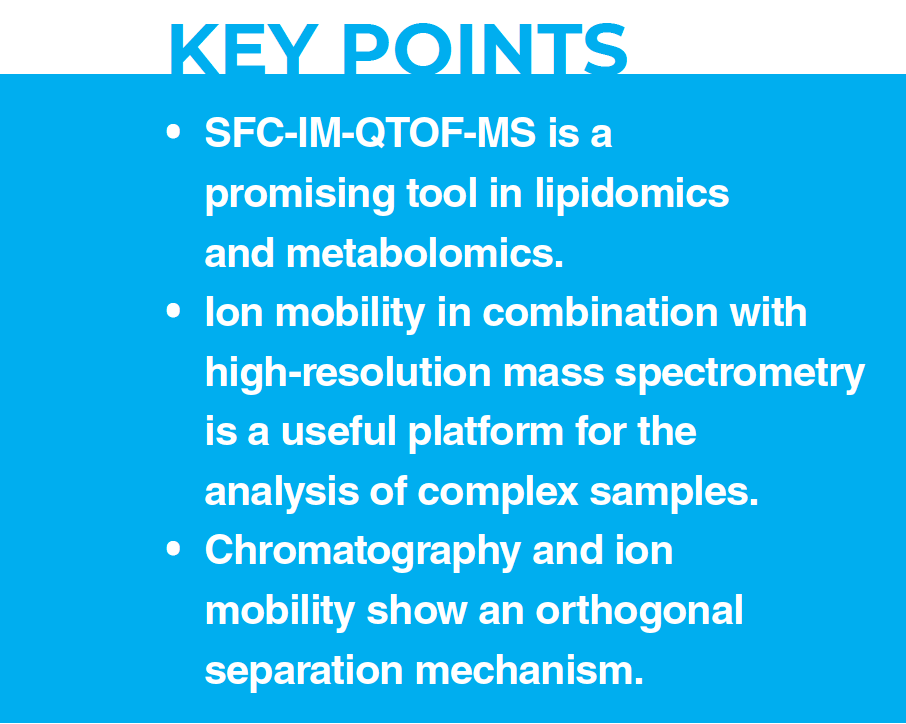
HepG2 cells (Figure 1) are widely used as an in vivo liver model system to study the beneficial or toxic effects of different compounds. However, the effects are mostly determined by cell viability, or the influence of a drug in a known metabolomic pathway is investigated. Only a few studies exist that are focused on investigating the complete metabolome and/or lipidome of HepG2 cells (1). Such studies make it possible to monitor large numbers of metabolic pathways simultaneously and can describe the effects in biological studies more precisely. For lipidomic studies, shotgun mass spectrometry (MS) and reversed-phase liquid chromatography coupled with MS (LC–MS) are often used. The chromatographic separation offers the benefit of an additional identification parameter (retention time), as well as reduced ion suppression in the ion source as a result of previous separation (2,3). In comparison with reversed-phase LC, supercritical fluid chromatography (SFC) offers an orthogonal separation, and the lipids are separated mainly by their lipid classes (Figure 2) (2,4,5) instead of their carbon chain length and number of double bonds, which facilitates quantification with few standards. Ion mobility mass spectrometry (IM-MS) can be used to further separate the lipid classes after SFC.
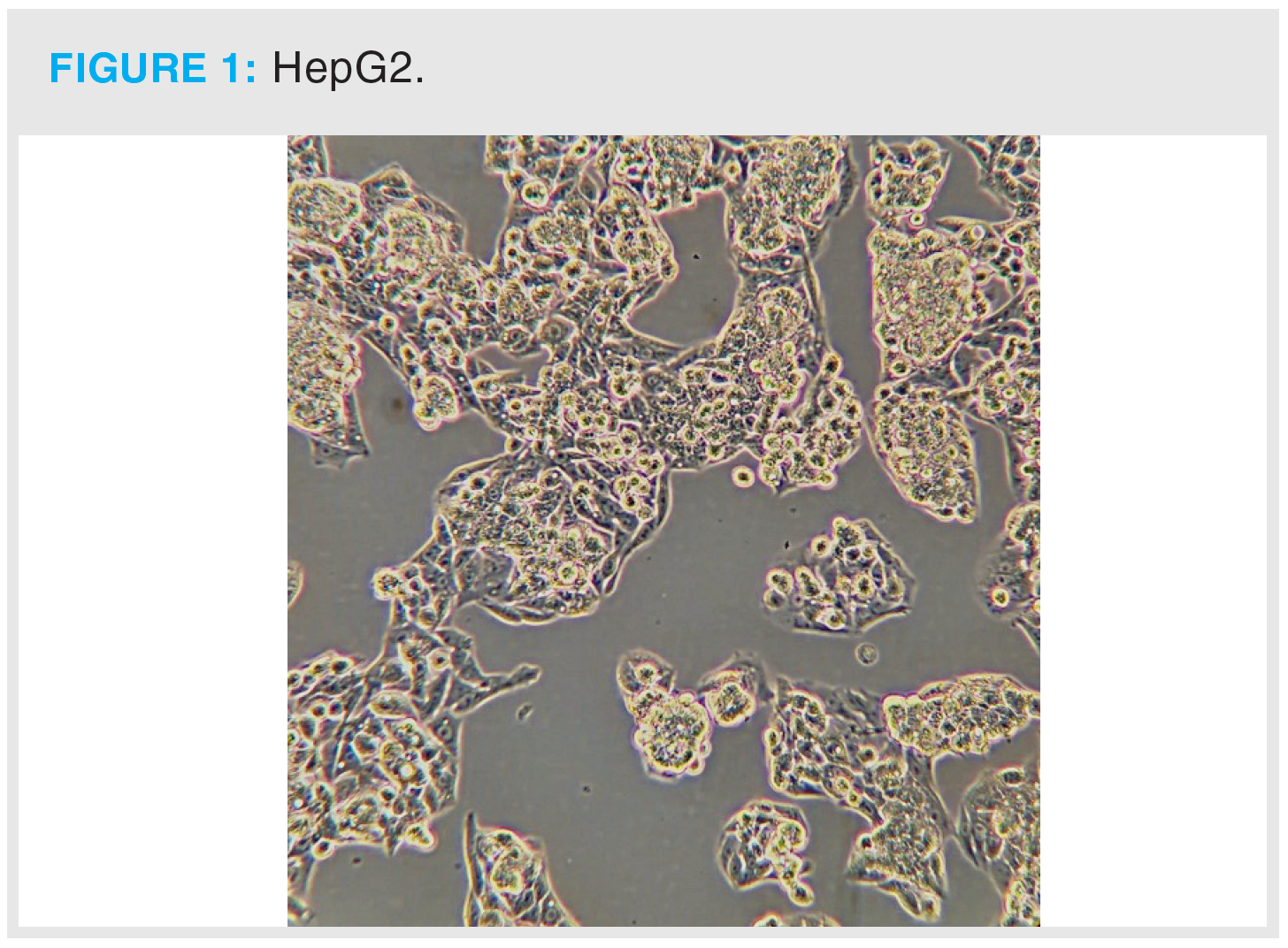
The coupling of ion mobility spectrometry (IMS) to mass spectrometry (MS) started in the 1960s and has experienced a strong development since the 1990s (7,8). The first commercially available IM-MS was a quadrupole/travelling-wave IMS/time-of-flight (TWIMS-TOF) system (9). In 2014, an IM‑QTOF-MS system using drift time IMS (DTIMS) was
released (10). New developments in this field include the introduction of a cyclic ion mobility spectrometry (cIMS) system (11), a trapped ion mobility (TIMS)-TOF system (12), and a structures for lossless ion manipulations (SLIM)-TOF instrument (13).
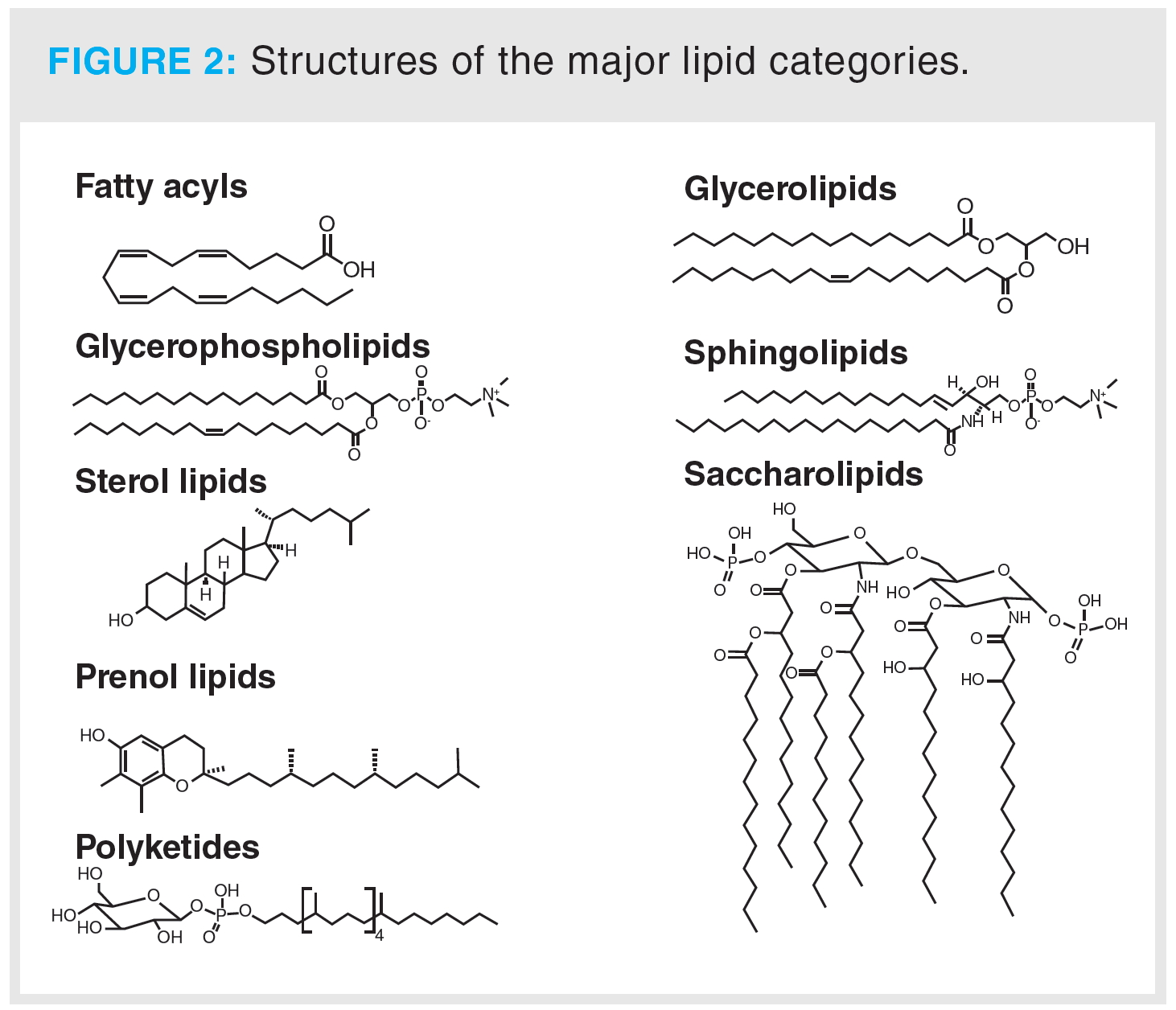
IMS separates ions according to their size/shape‑to‑charge ratio, and therefore has the ability to determine collision cross sections (CCS) of the ions (14). In comparison to other ion mobility techniques—where calibration has to be performed to determine CCS because a non‑uniform electric field is used (15)—drift tube ion mobility spectroscopy (DTIMS) allows CCS to be calculated directly from the observed drift times using the Mason-Schamp equation (16,17). Several CCS values—which are specific for certain substances—are available in the literature for different peptides, N-glycans, drug-like compounds, metabolites, lipids, and different biomolecules (18).
In this study, SFC was coupled to ion mobility quadrupole time-of-flight mass spectrometry (IM‑QTOF-MS) using electrospray ionization (ESI) and the lipidome of HepG2 cells was analyzed.
Materials and Methods
Chemicals and Biological Materials:
LC–MS-grade acetonitrile, LC–MS-grade methanol, LC–MS-grade 2-propanol, chloroform (stabilized with 0.6% ethanol), and LC-grade dichloromethane were obtained from VWR International. Gas chromatography (GC)-grade n-hexane, LC–MS-grade ammonium acetate, LC–MS-grade acetic acid, and Splash LipidoMix internal standard from Avanti polar lipids were purchased from Merck. CO2 (99.9995%) was obtained from Air Liquide. HepG2 cells, Dulbecco’s modified Eagle’s medium (DMEM):Ham’s F12 (1:1), foetal bovine serum (FBS), and all other cell culture reagents were purchased from CLS. Ultrapure water with a resistivity of 18.2 M Ω/cm was obtained using a water purification system (Sartorius Stedim).
Cell Culture and Lipid Extraction: HepG2 cells were maintained in Dulbecco’s modified eagle medium (DMEM) and Ham’s F12 medium (1:1), supplemented with 10% FBS, 50 U/mL penicillin, and 50 µg/mL streptomycin, at 37 °C, and 5% CO2. Pellets of 106 cells were stored at -80 °C until extraction.
Lipid extraction of the prepared cell pallets was performed by a two-step liquid–liquid extraction (LLE), using an isopropanol-hexane extraction in the first and an optimized Bligh and Dyer extraction in the second (19,20).
SFC-IM-QTOF-MS Analysis: Supercritical fluid chromatography was performed by injecting 1 µL of the obtained extract or lipid standard with a feed speed of 1 µL/min and a feed volume of 1 µL into the Agilent Infinity II SFC (Agilent Technologies), which was coupled to an Agilent 6560 drift tube IM-QTOF-MS system. Separation was performed using a 2.1 × 50 mm, 1.8-µm RX-SIL column (Agilent) and a gradient with A: CO2sc and B: 99:1 MeOH–H2O + 20 mM ammonium acetate. Initial conditions were 0.5% B, 0–1 min linear to 1.5% B, 1–6 min linear to 51% B, 6–8 min linear to 70% B, 8–10 min isocratic 70% B followed by 8 min at initial conditions for re-equilibration. The flow rate was 1 mL/min. The back pressure regulator was set at 200 bar and the column temperature was maintained at 60 °C. For the transfer of the SFC eluate to the mass spectrometer, an additional makeup flow of 99:1 0.25 mL/min MeOH–H2O was used.
Ionization was performed using the Dual Jet Stream source (Agilent) in positive mode. Nitrogen was used as a source gas and ionization was performed using the following settings: gas temp.: 325 °C; drying gas: 5 L/min; nebulizer: 20 psi; sheath gas temp.: 350 °C; sheath gas flow: 12 L/min; VCap: 4000 V; nozzle voltage: 500 V; fragmentor: 350 V; and Oct 1 RF Vpp: 750 V. The mass range was from 100 to 1700 m/z. Nitrogen was used as drift gas, trap fill time was 30 ms, and release time was 0.15 ms. Data were acquired within an m/z range from 100 to 1700 Da and a maximum drift time of 70 ms. Fragmentation data were acquired using the alternating frame mode by switching between high and no fragmentation energy between each IM frame. In the high energy mode, a linear ramped collision energy depending on the drift time was applied. From 0 ms to 10 ms, the collision energy was 10 V, linear ramp to 60 V at 59 ms, and from 60 ms to 70 ms 60 V. Cycle time was 0.14 s.
Data Analysis and Identification: Feature analysis for nontargeted lipidomics was carried out using Mass Profiler (10.0, Agilent) with the following parameters: measure of abundance: max ion volume; isotope model: common organic molecules, limit charge states to a range of 1–3, retention time tolerance ± 0.3 min, retention time range 0.3–8.0 min, drift time tolerance ± 1.5%, mass tolerance ± (10 ppm + 2 mDa), and minimum Q-Score of 40. CEF files, including fragmentation data, were extracted for lipid identification with the following parameters: no compound filters, retention time extraction window width ± 0 s, drift time extraction window width ± 0.5 ms, limit (by height) to the largest 15 fragment peaks, minimum absolute fragment peak height 100 counts, absolute fragment spectrum drift time offset -0.3 ms, and relative fragment spectrum drift time offset 0%. The identification of the lipids was performed using the LipidIMMS Analyzer (freely available software) (21).
Results and Discussion
Chromatographic Separation and Optimization: Lipid separation prior to mass spectrometric separation can be performed using reversed-phase LC (22–24), hydrophilic interaction liquid chromatography (HILIC) (24,25), or SFC (2,26). In reversed-phase LC-based separations, C18 columns that allow the separation of lipids based on the carbon chain length rather than the polar head group are commonly used. In contrast, HILIC- and SFC-based methods use polar columns, resulting in orthogonal separations. Accordingly, the interaction of the polar head group of the lipids is key for interaction with the stationary phase. Therefore, the lipid separation is based on the lipid species and all lipids of one species elute in one major peak. This has some benefits over conventional reversed-phase LC methods. Generally, a lipid species-based separation is often faster; SFC methods in particular offer short analysis times (26).
The developed SFC method was capable of separating major lipid classes (Figure 3) in under 8 min, while even short reversed-phase LC methods require around 15 min, as reported by Tötsch et al. (22) and Tsugawa et al. (23). Another advantage of class‑based separation is that quantification is easier. As all compounds of one species elute in one peak, ion suppression is similar for all compounds in that peak and quantification can be carried out using just a few standards (25). In a reversed-phase LC-based method, individual lipids of one class, such as phosphatidylcholines (PC) or triacylglycerides (TG), elute over a wide time range. Hence, ion suppression can be vastly different and multiple standards have to be used for quantification.
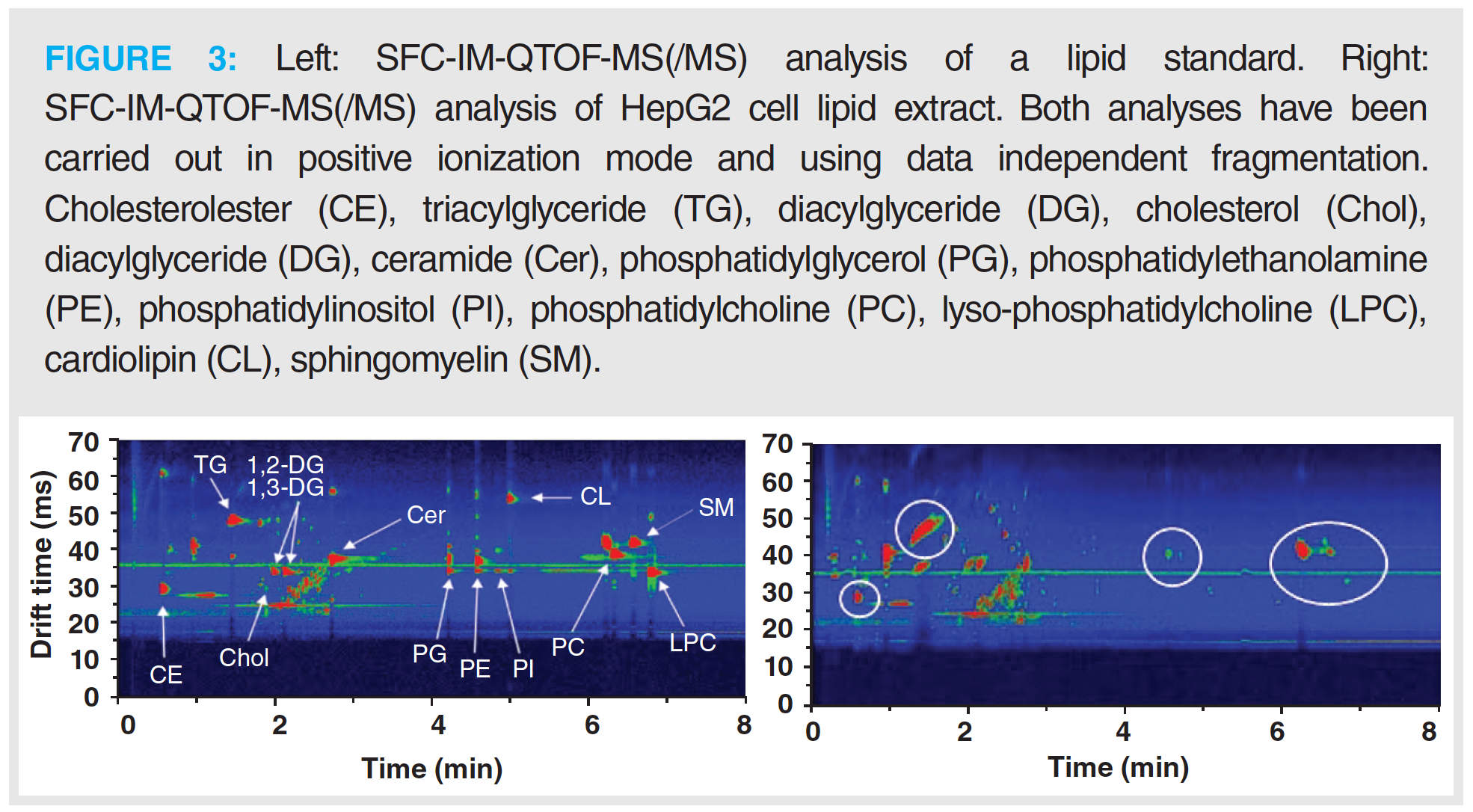
Figure 3 (left) shows the heat map obtained for the separation of a standard containing various lipids from different classes. As can be seen, nonpolar lipids such as TGs or cholesterolesters (CEs) eluted rather early, while polar (phospholipids) and charged lipids (sphingomyelins) showed strong retention. The separation also provided good peak shapes and peak symmetries for all lipids, ranging from nonpolar to polar and charged lipids (Figure 4). However, the separation depends not just on the lipid class, as there is a slight separation for the lipids within each class (26). It also depends on the number of double bonds and the total carbon number of the side chains that contribute overall to the polarity of the molecule.
For example, for the TG(52:1), the observed retention time was 1.39 min, and for the TG(52:4) 1.47 min. Considering the small peak width obtained from the SFC separation, baseline separation of both lipids was observed.
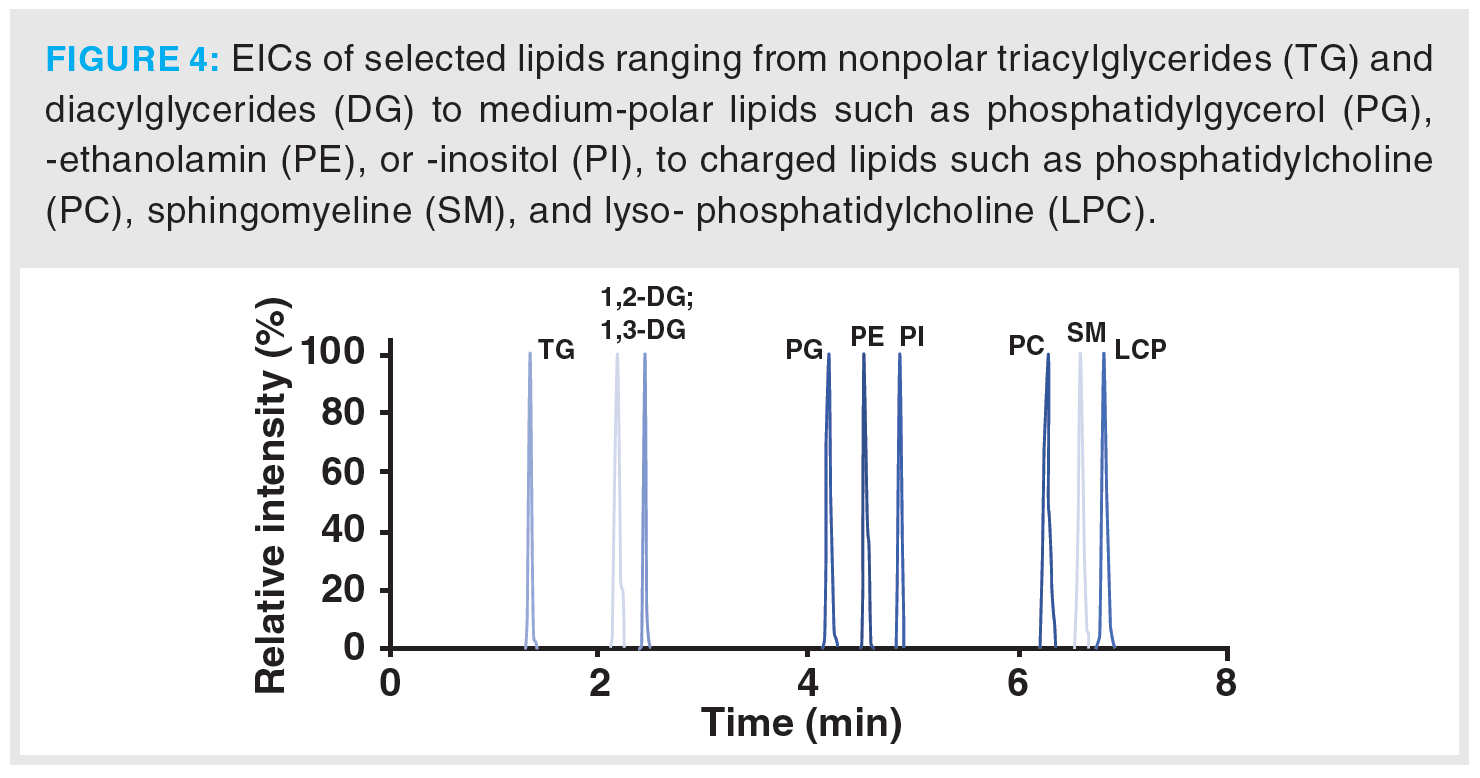
Figure 3 shows the separation of a HepG2 cell sample after extraction by SFC-IM-QTOF-MS. The direct comparison of both heat maps allows for a quick evaluation of the lipidome. As highlighted, large amounts of CEs and TG were detected at the beginning. In addition, the phospholipid composition was evaluated quickly and was rather simple, consisting of mostly PCs and some lyso- phosphatidylcholines (LPC) and phosphatidylethanolamines (PE).
Ion Mobility and Drift Time Aligned Fragmentation: Ion mobility can increase the separation power of a method by introducing an additional dimension that allows the separation by the shape-to‑charge of a molecule. This can eventually lead to the separation of coeluting isomers that cannot be separated by chromatography or mass spectrometry, hence increasing the coverage of the detected molecules. Moreover, ion mobility provides the CCS as an intrinsic factor that aids in the identification of metabolites or lipids in complex biological samples. Today, programs are available that allow the identification of lipids using in silico databases, such as LipidIMMS Analyzer (21), Lipid4DAnalyzer (27), or MS-Dial (28) (freely available software), and can make use of the full potential of IM-MS. In silico databases for CCS values work well for lipids, as their structures follow rules that makes predictions easier compared to other structurally more diverse molecules (for example, metabolites). This also holds true for MS/MS libraries, such as LipidBlast (freely available software). Together, the CCS and MS/MS spectra can contribute to more accurate identification of lipids essential for application in systems biology or precision medicine.
In this study, the alternating frame method was used to acquire all ion fragmentation data of the lipids. In detail, an IM-frame is the sum of several transients of ion packages travelling through the drift tube to increase the signal-to-noise ratio. After a frame without any fragmentation energy to acquire the m/z of the molecule ions, fragmentation energy is applied. As the fragmentation takes place after the drift tube, the drift time of the molecule ion and the fragment ions are the same (Figure 5). Because it is performed in an alternating manner, fragmentation spectra are acquired during the whole analysis.
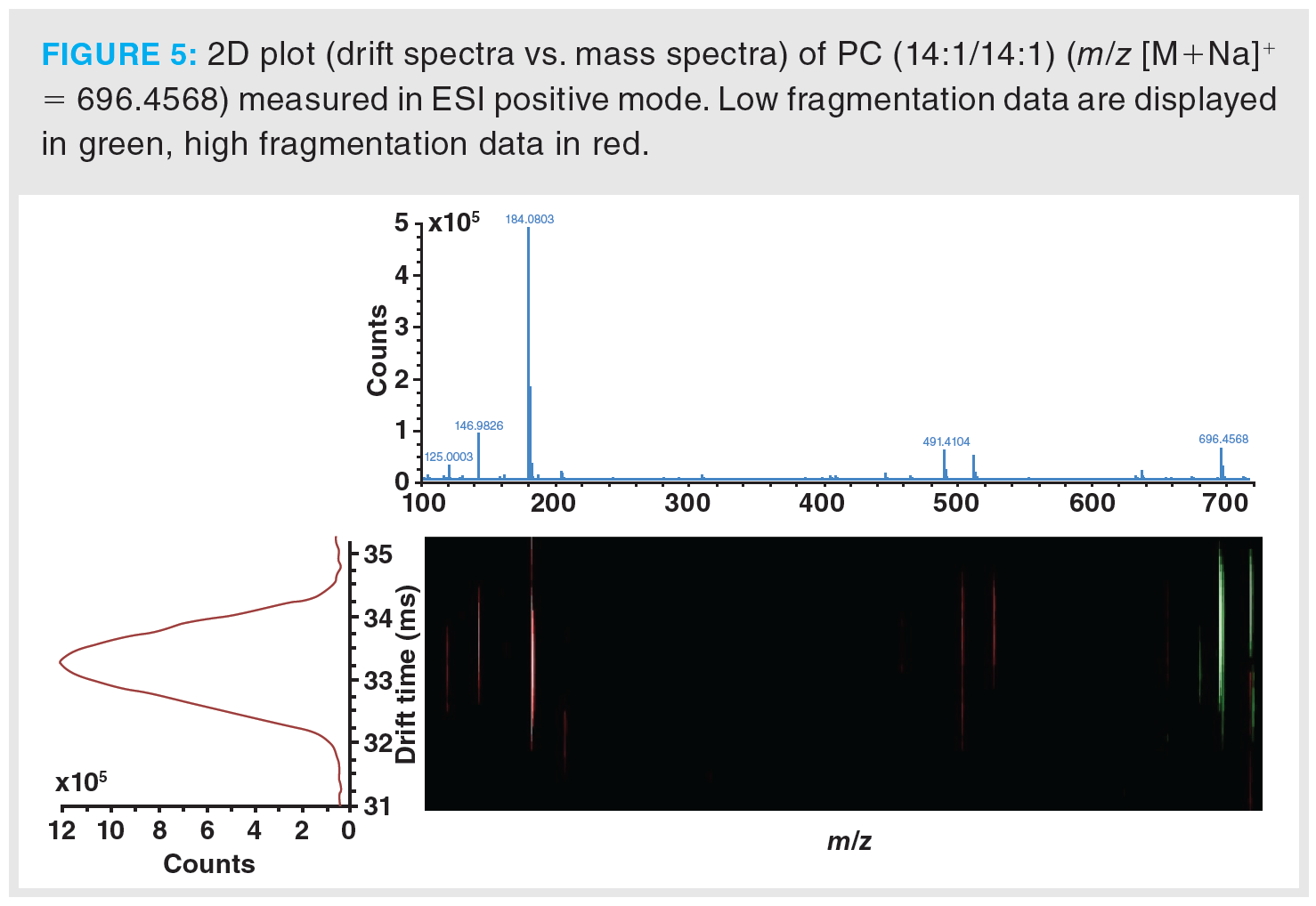
Feature Analysis and Detected Lipids: Using the described SFC-IM-QTOF-MS method, the lipidome of HepG2 cells that are frequently used in studies as an in vivo liver model system to investigate beneficial or toxic effects of different compounds was analyzed. The cells were extracted using LLE, and the lipid analysis was carried out as described. The resulting data were further processed using software for feature analysis, and for lipid identification based on CCS value and fragmentation data the LipidIMMS Analyzer (21) was used. In total, 214 lipids were detected and identified by ionization in positive mode only. To increase the coverage, the analysis can also be performed in negative ionization mode. Figure 6 gives an overview of the detected and identified lipids as an ion map, showing the CCS value and m/z ratio of all identified lipids. The most diverse class was triacylglycerols, with 103 different detected species. In addition, a large variety of diacylglycerols, phosphatidylcholines, phosphatidylethanolamines, lyso- phosphatidylcholines ceramides, and sphingomyelins were detected.
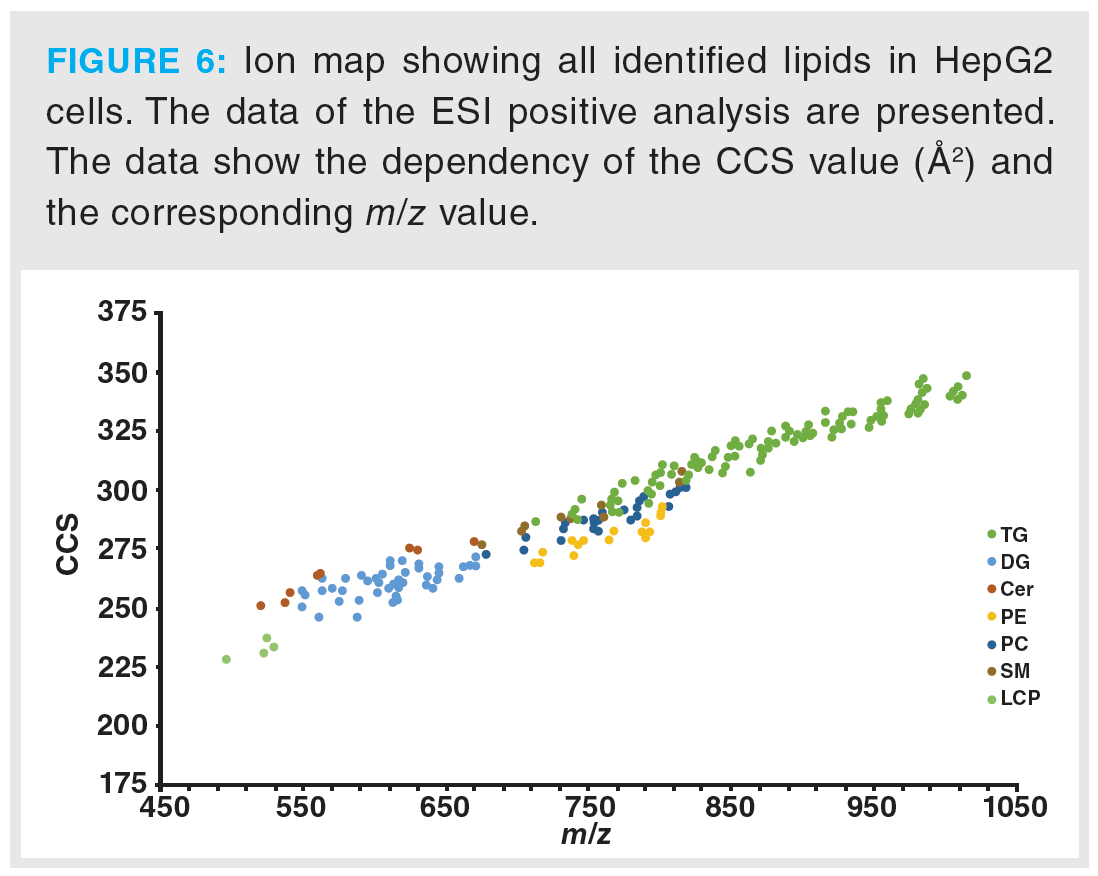
Conclusion
Ion mobility is a powerful technology that can help to separate coeluting isobaric compounds, and offers an additional parameter for identification. Together with chromatographic separation and high-resolution MS, it is a valuable tool for the analysis of lipids and metabolites in complex biological samples. In the present study, a method for the analysis of lipids in cell samples using SFC and IM-QTOF-MS was developed. The method was capable of acquiring drift time aligned ion fragmentation for further structural identification. The method provided excellent peak shape for all lipid classes, such as nonpolar triacylglycerides, polar phosphatidylethanolamines, or charged lipids such as phosphatidylcholines.
SFC-IM-QTOF-MS is another valuable tool that combines fast analysis times and accurate identification, all of which are necessary to answer questions in systems biology and precision medicine.
References
- L.J. Zhao, H.Y. Zhao, X.L. Wei, et al., J. Ethnopharmacol. 260, 112943 (2020). 10.1016/j.jep.2020.112943.
- M. Lisa and M. Holcapek, Anal. Chem. 87(14), 7187–95 (2015). 10.1021/acs.analchem.5b01054.
- C. Hinz, S. Liggi, G. Mocciaro, et al., Anal. Chem. 91(13), 8025–8035 (2019). 10.1021/acs.analchem.8b04615.
- X. Shi, W. Yang, S. Qiu, et al., J. Chromatogr. A
1548, 64–75 (2018). 10.1016/j.chroma.2018.03.025. - T. Xia, M. Yuan, Y. Xu, et al., Anal. Chem. 93(23), 8345–8353 (2021). 10.1021/acs.analchem.1c01379.
- E. Fahy, S. Subramaniam, H.A. Brown, et al., J. Lipid Res. 46(5), 839–61 (2005). 10.1194/jlr.E400004-JLR200.
- R. Mukhopadhyay, Anal. Chem. 80(21), 7918–20 (2008). 10.1021/ac8018608.
- C. Lapthorn, F. Pullen, and B.Z. Chowdhry, Mass Spectrom. Rev. 32(1), 43–71 (2013). 10.1002/mas.21349.
- S.D. Pringle, K. Giles, J.L. Wildgoose, et al., International Journal of Mass Spectrometry 261(1), 1–12 (2007). 10.1016/j.ijms.2006.07.021.
- J.C. May and J.A. McLean, Anal. Chem. 87(3), 1422–36 (2015). 10.1021/ac504720m.
- K. Giles, J. Ujma, J. Wildgoose, et al., Anal. Chem. 91(13), 8564–8573 (2019). 10.1021/acs.analchem.9b01838.
- K. Michelmann, J.A. Silveira, M.E. Ridgeway, et al., J. Am. Soc. Mass Spectrom. 26(1), 14–24 (2015). 10.1007/s13361-014-0999-4.
- R. Wojcik, G. Nagy, I.K. Attah, et al., Anal. Chem. 91(18), 11952–11962 (2019). 10.1021/acs.analchem.9b02808.
- I. Campuzano, M.F. Bush, C.V. Robinson, et al., Anal. Chem. 84(2), 1026–33 (2012). 10.1021/ac202625t.
- J. Hofmann, W.B. Struwe, C.A. Scarff, et al., Anal. Chem. 86(21), 10789–95 (2014). 10.1021/ac5028353.
- A.B. Kanu, P. Dwivedi, M. Tam, et al., J. Mass Spectrom. 43(1), 1–22 (2008). 10.1002/jms.
1383. - L. Tao, J.R. McLean, J.A. McLean, et al., J. Am. Soc. Mass Spectrom. 18(7), 1232–8 (2007). 10.1016/j.jasms.2007.04.003.
- J.N. Dodds and E.S. Baker, J. Am. Soc. Mass Spectrom. 30(11), 2185–2195 (2019). 10.1007/s13361-019-02288-2.
- E.G. Bligh and W.J. Dyer, Can. J. Biochem. Physiol. 37(8), 911–7 (1959). 10.1139/o59-099.
- S.W. Meckelmann, J.I. Hawksworth, D. White, et al., Circ. Genom. Precis. Med. 13(3), e002806 (2020). 10.1161/CIRCGEN.119.002806.
- Z. Zhou, X. Shen, X. Chen, et al., Bioinformatics 35(4), 698–700 (2019). 10.1093/bioinformatics/bty661.
- K. Tötsch, J.C. Fjeldsted, S.M. Stow, et al., J. Am. Soc. Mass Spectrom. 32(10), 2592–2603 (2021). 10.1021/jasms.1c00217.
- H. Tsugawa, T. Cajka, T. Kind, et al., Nat. Methods 12(6), 523–6 (2015). 10.1038/nmeth.3393.
- M. Lange and M. Fedorova, Anal. Bioanal. Chem. 412(15), 3573–3584 (2020). 10.1007/s00216-020-02576-x.
- M. Lisa, E. Cifkova, M. Khalikova, et al., J. Chromatogr. A 1525, 96–108 (2017). 10.1016/j.chroma.2017.10.022.
- M. Lisa and M. Holcapek, Methods Mol. Biol.
1730, 73–82 (2018). 10.1007/978-1-4939-7592-1_5. - X. Chen, Y. Yin, Z. Zhou, et al., Anal. Chim. Acta. 1136, 115–124, (2020). 10.1016/j.aca.2020.08.048.
- H. Tsugawa, K. Ikeda, M. Takahashi, et al., Nat. Biotechnol. 38(10), 1159–1163, (2020). 10.1038/s41587-020-0531-2.
Oliver J. Schmitz became a full professor at the University of Duisburg-Essen in 2013 and is the chair of the Institute of Applied Analytical Chemistry. His research interests include the development of ion sources, the use and optimization of multidimensional LC and GC, ion mobility-mass spectrometry, and coupling analytical techniques with mass spectrometers. Furthermore he is also working on the origin of life and metabolomics. He was awarded the Gerhard-Hesse Prize for Chromatography in 2013 and the Waksmundzki Medal Award for Analytical Chemistry from the Polish Academy of Sciences in 2018.
Sven Meckelmann is an independent researcher and senior scientist at the University of Duisburg-Essen in the Department for Applied Analytical Chemistry of Prof. Dr. Oliver Schmitz where he has been since 2017. His research interests include the development and application of new methods for the identification and quantification of lipids and metabolites.
Pia Wittenhofer is currently a Ph.D. student in the Department for Applied Analytical Chemistry at the University of Duisburg-Essen, Germany. Her research focuses on the analysis of cholesterol biosynthesis using two-dimensional liquid chromatography coupled with ion mobility and high-resolution mass spectrometry.
Kristina Tštsch is currently a Ph.D. student in the Department for Applied Analytical Chemistry at the University of Duisburg-Essen, Germany. Her research focuses on nontargeted lipid analysis using liquid chromatography coupled to ion mobility and high‑resolution mass spectrometry.
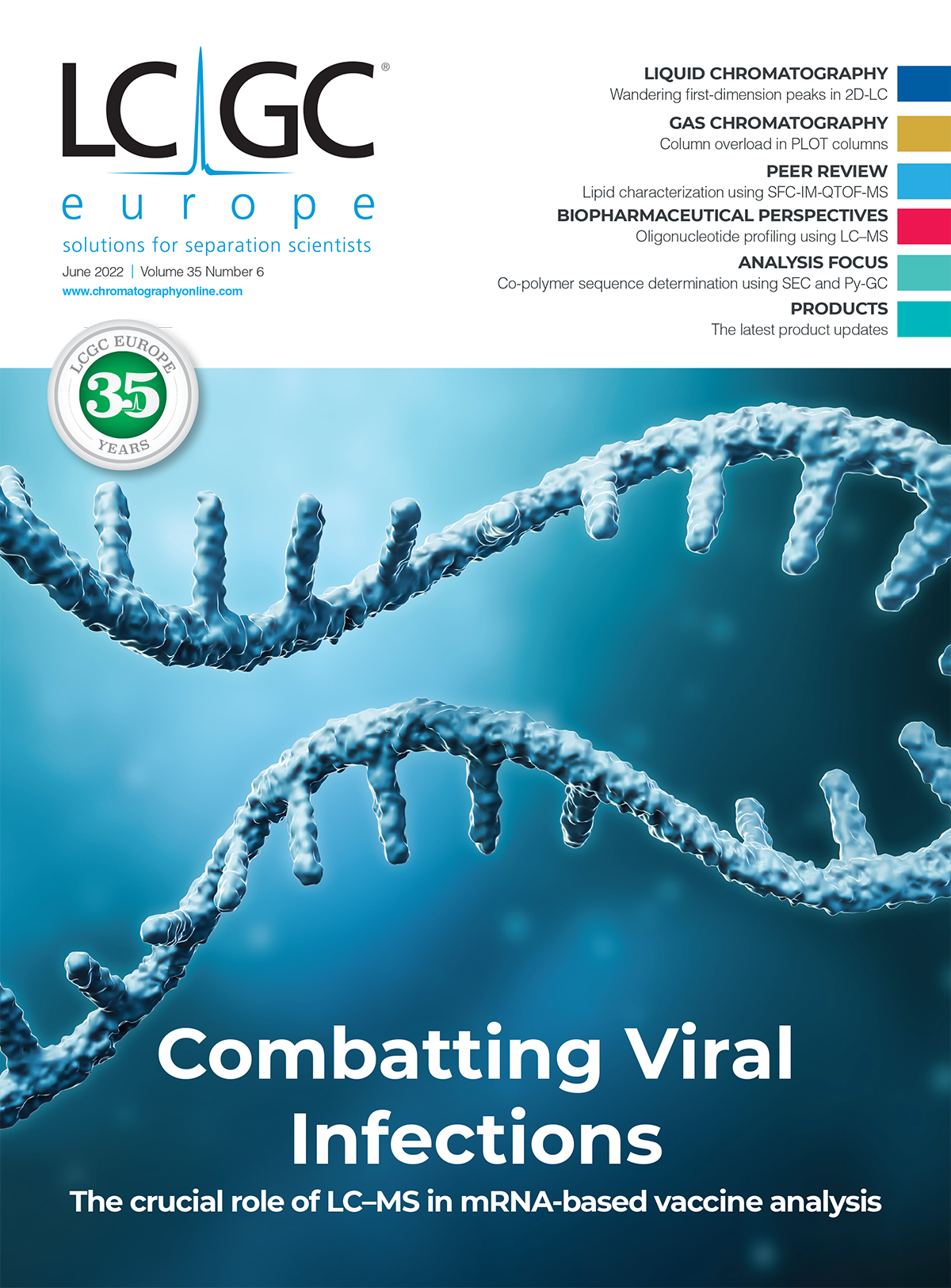
Separating Impurities from Oligonucleotides Using Supercritical Fluid Chromatography
February 21st 2025Supercritical fluid chromatography (SFC) has been optimized for the analysis of 5-, 10-, 15-, and 18-mer oligonucleotides (ONs) and evaluated for its effectiveness in separating impurities from ONs.

.png&w=3840&q=75)

.png&w=3840&q=75)



.png&w=3840&q=75)



.png&w=3840&q=75)





